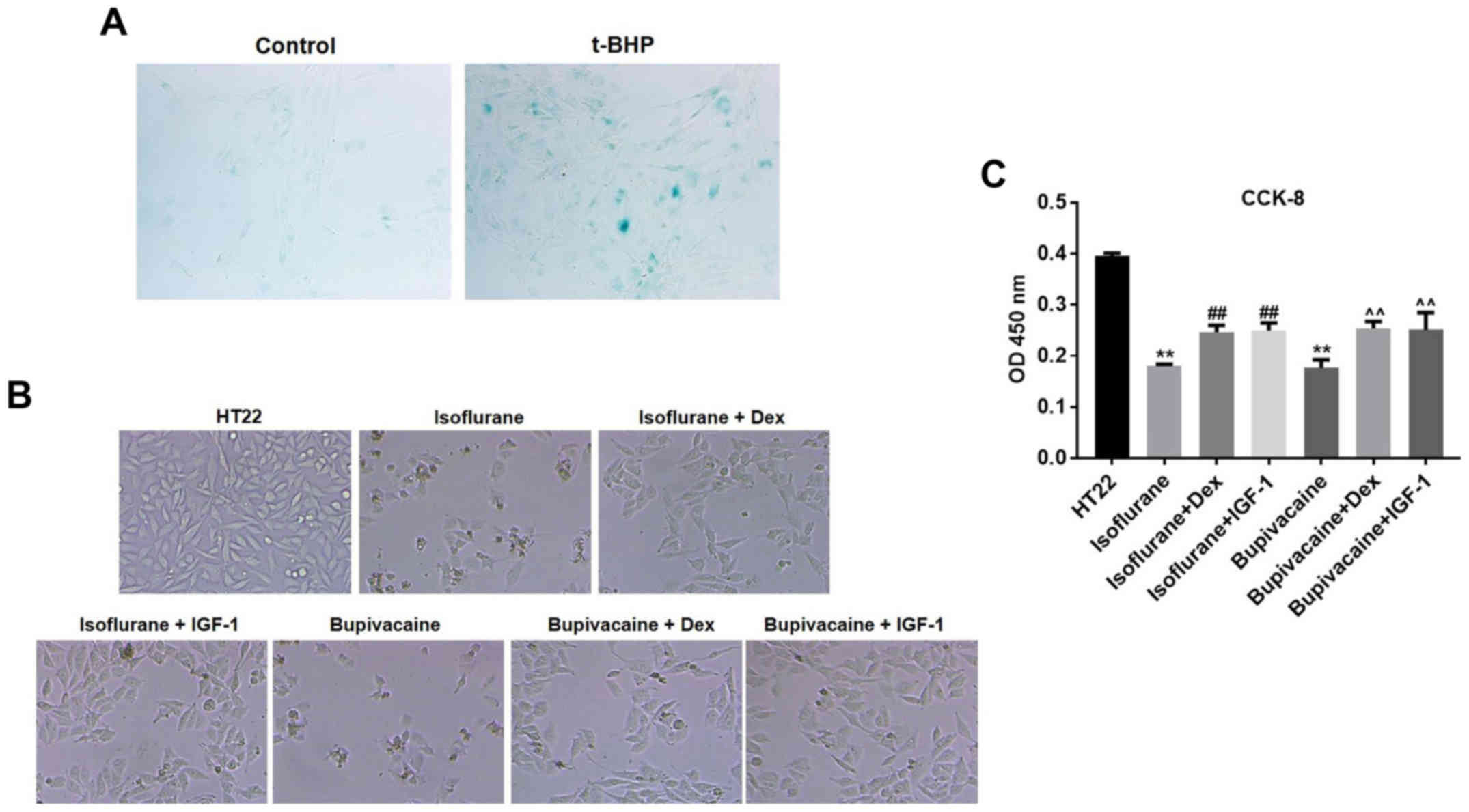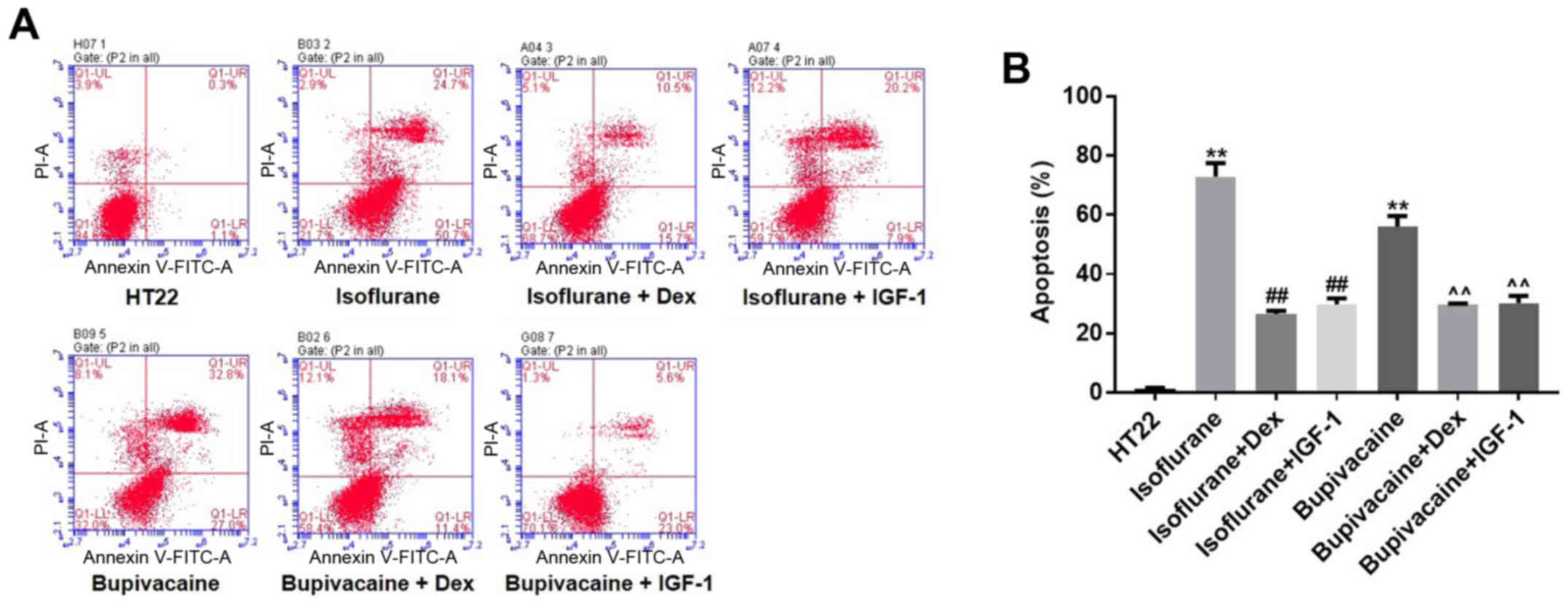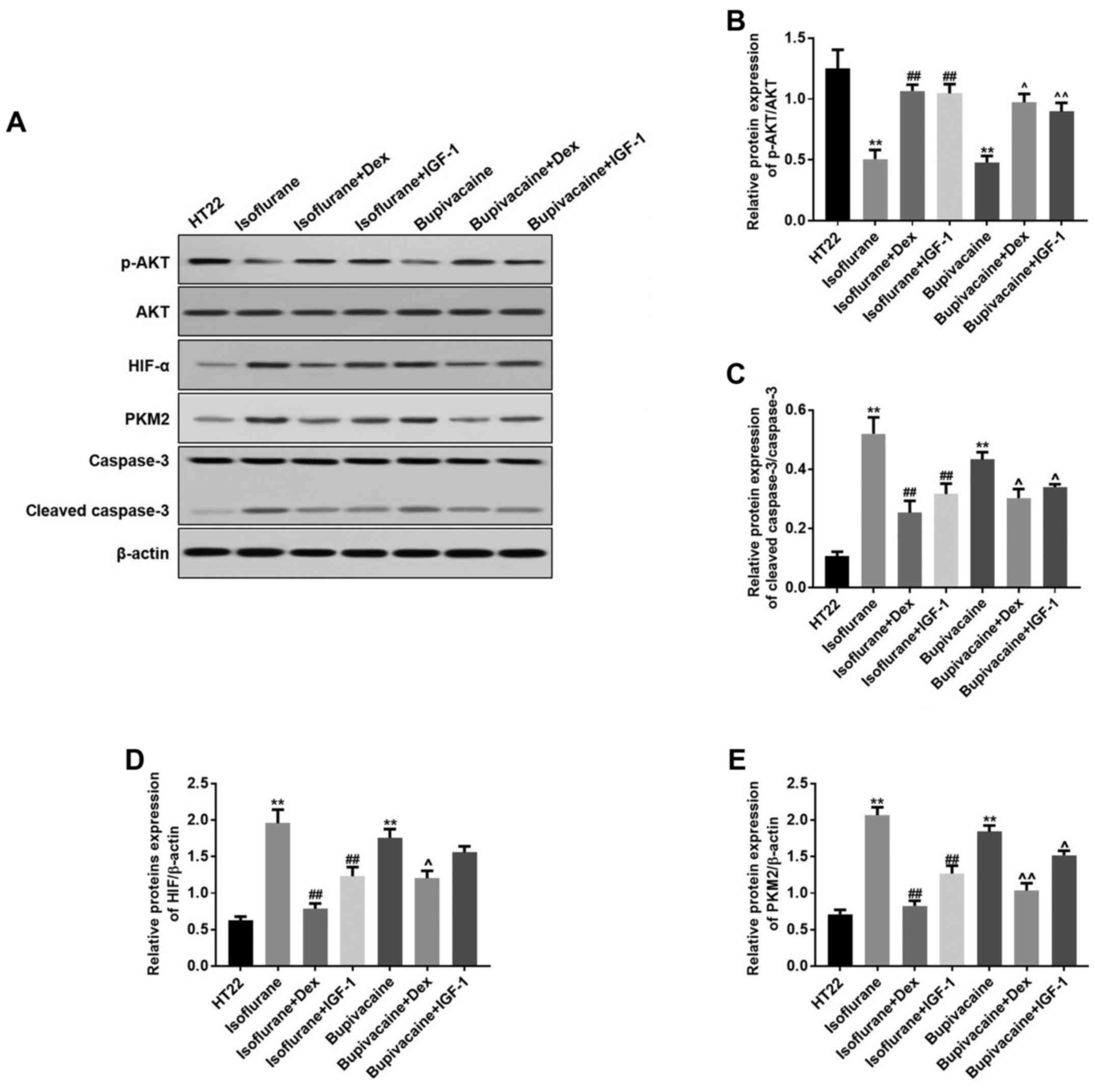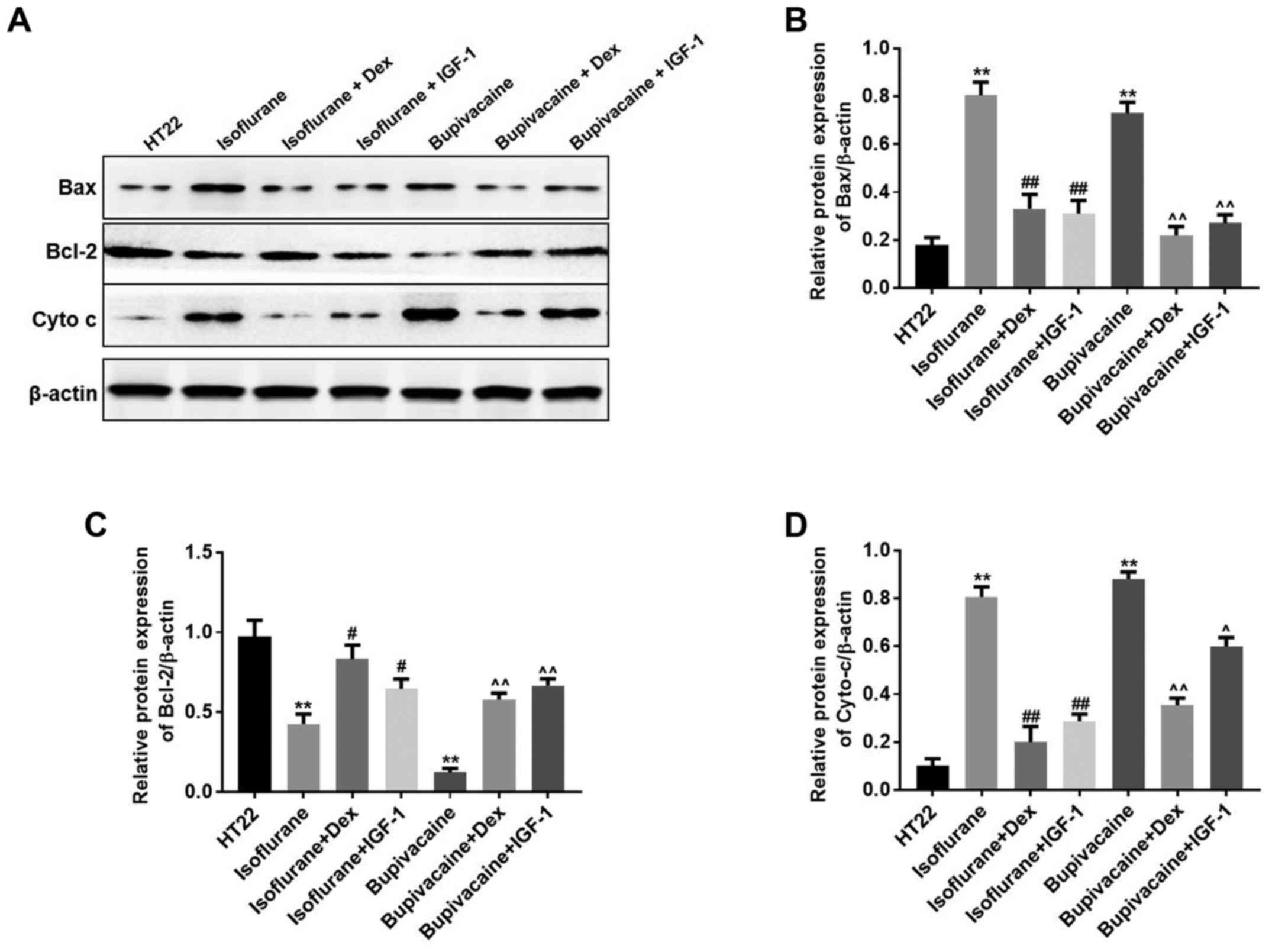|
1
|
Kehlet H and Dahl JB: Anaesthesia,
surgery, and challenges in postoperative recovery. Lancet.
362:1921–1928. 2003. View Article : Google Scholar : PubMed/NCBI
|
|
2
|
Xie Z, Culley DJ, Dong Y, Zhang G, Zhang
B, Moir RD, Frosch MP, Crosby G and Tanzi RE: The common inhalation
anesthetic isoflurane induces caspase activation and increases
amyloid beta-protein level in vivo. Ann Neurol. 64:618–627. 2008.
View Article : Google Scholar : PubMed/NCBI
|
|
3
|
Malik O, Kaye AD, Kaye A, Belani K and
Urman RD: Emerging roles of liposomal bupivacaine in anesthesia
practice. J Anaesthesiol Clin Pharmacol. 33:151–156.
2017.PubMed/NCBI
|
|
4
|
Li Y, Zeng M, Chen W, Liu C, Wang F, Han
X, Zuo Z and Peng S: Dexmedetomidine reduces isoflurane-induced
neuroapoptosis partly by preserving PI3K/Akt pathway in the
hippocampus of neonatal rats. PLoS One. 9:e936392014. View Article : Google Scholar : PubMed/NCBI
|
|
5
|
Li L, Zhang QG, Lai LY, Wen XJ, Zheng T,
Cheung CW, Zhou SQ and Xu SY: Neuroprotective effect of ginkgolide
B on bupivacaine-induced apoptosis in SH-SY5Y cells. Oxid Med Cell
Longev. 2013:1598642013. View Article : Google Scholar : PubMed/NCBI
|
|
6
|
Peng J, Drobish JK, Liang G, Wu Z, Liu C,
Joseph DJ, Abdou H, Eckenhoff MF and Wei H: Anesthetic
preconditioning inhibits isoflurane-mediated apoptosis in the
developing rat brain. Anesth Analg. 119:939–946. 2014. View Article : Google Scholar : PubMed/NCBI
|
|
7
|
Malikova J, Zdarilova A and Hlobilkova A:
Effects of sanguinarine and chelerythrine on the cell cycle and
apoptosis. Biomed Pap Med Fac Univ Palacky Olomouc Czech Repub.
150:5–12. 2006. View Article : Google Scholar : PubMed/NCBI
|
|
8
|
Sun J, Chen XL, Zheng JY, Zhou JW and Ma
ZL: Astragaloside IV protects new born rats from anesthesia-induced
apoptosis in the developing brain. Exp Ther Med. 12:1829–1835.
2016. View Article : Google Scholar : PubMed/NCBI
|
|
9
|
Becker EB and Bonni A: Cell cycle
regulation of neuronal apoptosis in development and disease. Prog
Neurobiol. 72:1–25. 2004. View Article : Google Scholar : PubMed/NCBI
|
|
10
|
Raynaud F and Marcilhac A: Implication of
calpain in neuronal apoptosis. A possible regulation of Alzheimer's
disease. FEBS J. 273:3437–3443. 2006. View Article : Google Scholar : PubMed/NCBI
|
|
11
|
Tatton NA: Increased caspase 3 and Bax
immunoreactivity accompany nuclear GAPDH translocation and neuronal
apoptosis in Parkinson's disease. Exp Neurol. 166:29–43. 2000.
View Article : Google Scholar : PubMed/NCBI
|
|
12
|
Koh MY, Darnay BG and Powis G:
Hypoxia-associated factor, a novel E3-ubiquitin ligase, binds and
ubiquitinates hypoxia-inducible factor 1alpha, leading to its
oxygen-independent degradation. Mol Cell Biol. 28:7081–7095. 2008.
View Article : Google Scholar : PubMed/NCBI
|
|
13
|
de Wit RH, Mujić-Delić A, van Senten JR,
Fraile-Ramos A, Siderius M and Smit MJ: Human cytomegalovirus
encoded chemokine receptor US28 activates the HIF-1α/PKM2 axis in
glioblastoma cells. Oncotarget. 7:67966–67985. 2016. View Article : Google Scholar : PubMed/NCBI
|
|
14
|
Li D, Qu X, Hou K, Zhang Y, Dong Q, Teng
Y, Zhang J and Liu Y: PI3K/Akt is involved in bufalin-induced
apoptosis in gastric cancer cells. Anticancer Drugs. 20:59–64.
2009. View Article : Google Scholar : PubMed/NCBI
|
|
15
|
Franke TF, Hornik CP, Segev L, Shostak GA
and Sugimoto C: PI3K/Akt and apoptosis: Size matters. Oncogene.
22:8983–8998. 2003. View Article : Google Scholar : PubMed/NCBI
|
|
16
|
Osaki M, Oshimura M and Ito H: PI3K-Akt
pathway: Its functions and alterations in human cancer. Apoptosis.
9:667–676. 2004. View Article : Google Scholar : PubMed/NCBI
|
|
17
|
Tüfek A, Kaya S, Tokgöz O, Firat U,
Evliyaoğlu O, Çelik F and Karaman H: The protective effect of
dexmedetomidine on bupivacaine-induced sciatic nerve inflammation
is mediated by mast cells. Clin Invest Med. 36:E95–E102. 2013.
View Article : Google Scholar : PubMed/NCBI
|
|
18
|
Zhao C, Chen X, Zhu Y, Zeng Y and Jin J: A
senescence model induced by tertbutyl-hydroperoxide in rats. J
Fujian Medical Univ. 37:19–22. 2003.
|
|
19
|
Annunziato L, Amoroso S, Pannaccione A,
Cataldi M, Pignataro G, D'Alessio A, Sirabella R, Secondo A, Sibaud
L and Di Renzo GF: Apoptosis induced in neuronal cells by oxidative
stress: Role played by caspases and intracellular calcium ions.
Toxicol Lett. 139:125–133. 2003. View Article : Google Scholar : PubMed/NCBI
|
|
20
|
Kogo J, Takeba Y, Kumai T, Kitaoka Y,
Matsumoto N, Ueno S and Kobayashi S: Involvement of TNF-alpha in
glutamate-induced apoptosis in a differentiated neuronal cell line.
Brain Res. 1122:201–208. 2006. View Article : Google Scholar : PubMed/NCBI
|
|
21
|
Lauritzen I, Zanzouri M, Honoré E, Duprat
F, Ehrengruber MU, Lazdunski M and Patel AJ: K+-dependent
cerebellar granule neuron apoptosis. Role of task leak K+ channels.
J Biol Chem. 278:32068–32076. 2003. View Article : Google Scholar : PubMed/NCBI
|
|
22
|
Sanders RD, Xu J, Shu Y, Januszewski A,
Halder S, Fidalgo A, Sun P, Hossain M, Ma D and Maze M:
Dexmedetomidine attenuates isoflurane-induced neurocognitive
impairment in neonatal rats. Anesthesiology. 110:1077–1085. 2009.
View Article : Google Scholar : PubMed/NCBI
|
|
23
|
Auroy Y, Benhamou D, Bargues L, Ecoffey C,
Falissard B, Mercier FJ, Bouaziz H and Samii K: Major complications
of regional anesthesia in France: The SOS Regional Anesthesia
Hotline Service. Anesthesiology. 97:1274–1280. 2002. View Article : Google Scholar : PubMed/NCBI
|
|
24
|
Park CJ, Park SA, Yoon TG, Lee SJ, Yum KW
and Kim HJ: Bupivacaine induces apoptosis via ROS in the Schwann
cell line. J Dent Res. 84:852–857. 2005. View Article : Google Scholar : PubMed/NCBI
|
|
25
|
Liang G, Wang Q, Li Y, Kang B, Eckenhoff
MF, Eckenhoff RG and Wei H: A presenilin-1 mutation renders neurons
vulnerable to isoflurane toxicity. Anesth Analg. 106:492–500. 2008.
View Article : Google Scholar : PubMed/NCBI
|
|
26
|
Zhao X, Yang Z, Liang G, Wu Z, Peng Y,
Joseph DJ, Inan S and Wei H: Dual effects of isoflurane on
proliferation, differentiation, and survival in human
neuroprogenitor cells. Anesthesiology. 118:537–549. 2013.
View Article : Google Scholar : PubMed/NCBI
|
|
27
|
Yang H, Liang G, Hawkins BJ, Madesh M,
Pierwola A and Wei H: Inhalational anesthetics induce cell damage
by disruption of intracellular calcium homeostasis with different
potencies. Anesthesiology. 109:243–250. 2008. View Article : Google Scholar : PubMed/NCBI
|
|
28
|
Zhao Y, Liang G, Chen Q, Joseph DJ, Meng
Q, Eckenhoff RG, Eckenhoff MF and Wei H: Anesthetic-induced
neurodegeneration mediated via inositol 1,4,5-trisphosphate
receptors. J Pharmacol Exp Ther. 333:14–22. 2010. View Article : Google Scholar : PubMed/NCBI
|
|
29
|
Griffiths JD, Le NV, Grant S, Bjorksten A,
Hebbard P and Royse C: Symptomatic local anaesthetic toxicity and
plasma ropivacaine concentrations after transversus abdominis plane
block for Caesarean section. Br J Anaesth. 110:996–1000. 2013.
View Article : Google Scholar : PubMed/NCBI
|
|
30
|
Gibbs NM and Rodoreda P: Primary
anaesthetic deaths in Western Australia from 1985–2008: Causation
and preventability. Anaesth Intensive Care. 41:302–310.
2013.PubMed/NCBI
|
|
31
|
Perez-Castro R, Patel S, Garavito-Aguilar
ZV, Rosenberg A, Recio-Pinto E, Zhang J, Blanck TJ and Xu F:
Cytotoxicity of local anesthetics in human neuronal cells. Anesth
Analg. 108:997–1007. 2009. View Article : Google Scholar : PubMed/NCBI
|
|
32
|
Arai Y, Kondo T, Tanabe K, Zhao QL, Li FJ,
Ogawa R, Li M and Kasuya M: Enhancement of hyperthermia-induced
apoptosis by local anesthetics on human histiocytic lymphoma U937
cells. J Biol Chem. 277:18986–18993. 2002. View Article : Google Scholar : PubMed/NCBI
|
|
33
|
Cela O, Piccoli C, Scrima R, Quarato G,
Marolla A, Cinnella G, Dambrosio M and Capitanio N: Bupivacaine
uncouples the mitochondrial oxidative phosphorylation, inhibits
respiratory chain complexes I and III and enhances ROS production:
Results of a study on cell cultures. Mitochondrion. 10:487–496.
2010. View Article : Google Scholar : PubMed/NCBI
|
|
34
|
Peng K, Wu SR, Ji FH and Li J:
Premedication with dexmedetomidine in pediatric patients: A
systematic review and meta-analysis. Clinics (Sao Paulo).
69:777–786. 2014. View Article : Google Scholar : PubMed/NCBI
|
|
35
|
Xia ZQ, Chen SQ, Yao X, Xie CB, Wen SH and
Liu KX: Clinical benefits of dexmedetomidine versus propofol in
adult intensive care unit patients: A meta-analysis of randomized
clinical trials. J Surg Res. 185:833–843. 2013. View Article : Google Scholar : PubMed/NCBI
|
|
36
|
Liu JR, Yuki K, Baek C, Han XH and Soriano
SG: Dexmedetomidine-induced neuroapoptosis is dependent on its
cumulative dose. Anesth Analg. 123:1008–1017. 2016. View Article : Google Scholar : PubMed/NCBI
|
|
37
|
Kim KH, Seo HS, Choi HS, Choi I, Shin YC
and Ko SG: Induction of apoptotic cell death by ursolic acid
through mitochondrial death pathway and extrinsic death receptor
pathway in MDA-MB-231 cells. Arch Pharm Res. 34:1363–1372. 2011.
View Article : Google Scholar : PubMed/NCBI
|
|
38
|
Chen G, Feng W, Zhang S, Bian K, Yang Y,
Fang C, Chen M, Yang J and Zou X: Metformin inhibits gastric cancer
via the inhibition of HIF1α/PKM2 signaling. Am J Cancer Res.
5:1423–1434. 2015.PubMed/NCBI
|


















